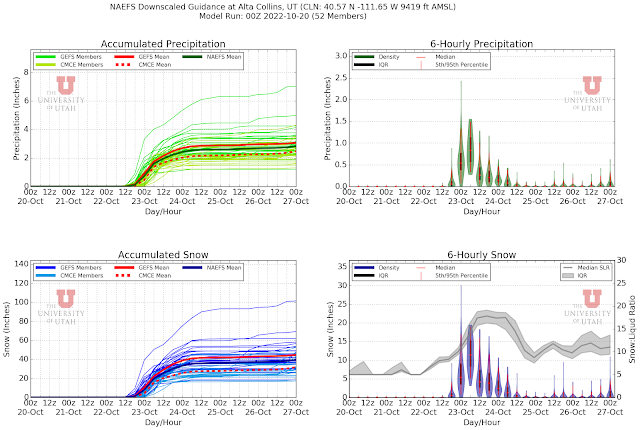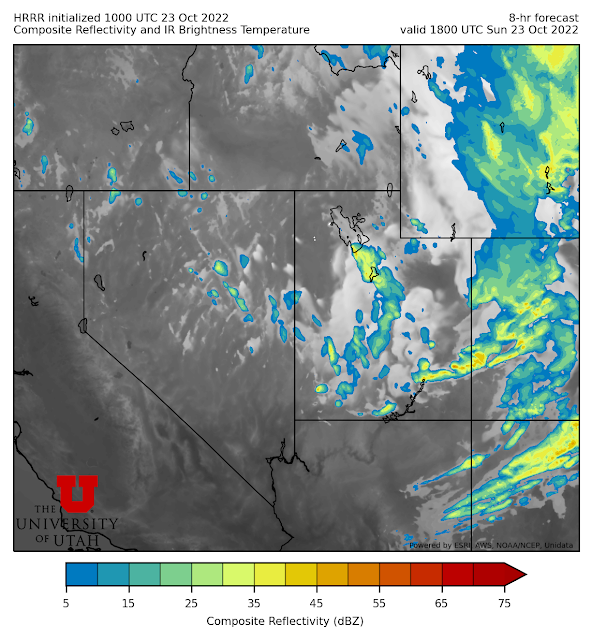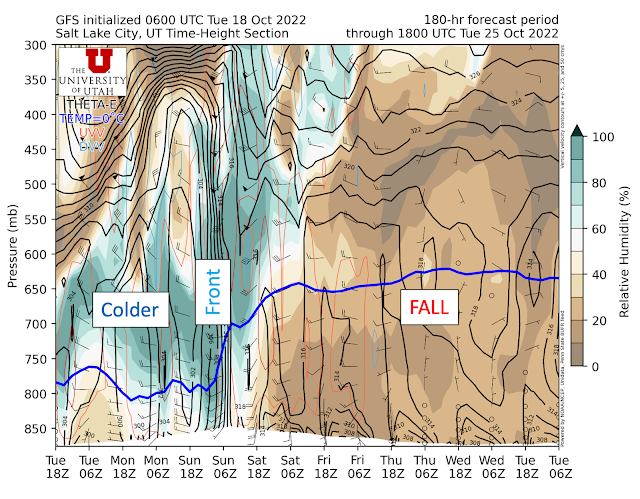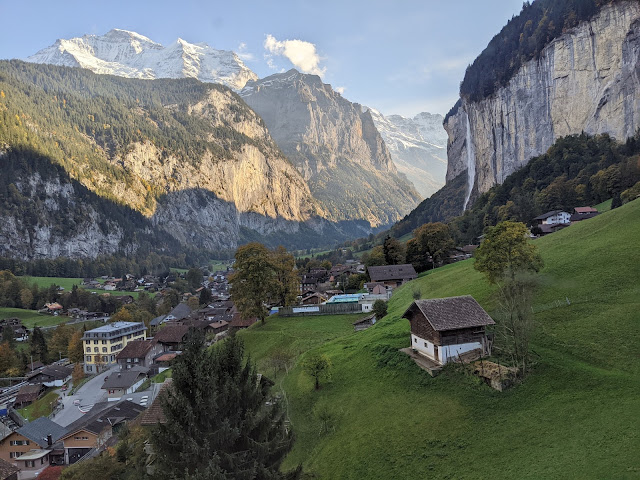For the first time in many years, my teaching schedule allowed me to travel over a two-week period in early October, including last week's spring break. Andrea and I had not returned to Innsbruck since we lived there during my sabbatical in 2019 and we wanted to see friends there. We also thought it might be a good time of year to visit the Jungfrau of Switzerland, which is the focus of this post.
I've wanted to visit the Jungfrau since reading Jon Krakauer's Eiger Dreams. Watching the Lauberhorn Downhill and its incredible mountain backdrops, also increased the stoke.
The Jungfrau region lies south of Interlaken, Switzerland and includes the Junfrau Massif (consisting of the Eiger, Mönch, and Jungfrau), the Lauterbrunnen Valley, the Grindelwald Valley, and the villages of Grindelwald, Wengen, Lauterbrunnen, and Mürren amongst many other peaks, valleys, and villages. I found it to be the Land of the Impossible due to the impossible relief, impossible mountain transportation system, impossible cog railroads, impossible cable cars, impossible beauty, and impossible costs.
We spent five days and four nights touring the region, using Mürren as our base. Mürren sits at 1638 meters on a precarious ledge above the Lauterbrunnen Valley. If you were a community in the middle ages, you could pick a better "natural fortress" to avoid marauders.
 |
| Mürren (center) from the Birg cablecar station with the Wetterhorn (far left), Eiger, Mönch, and Jungfrau behind. |
 |
| Mürren (top of cliff near center) from Klein Scheidegg. |
Even today, you can't drive a car to Mürren. I think there may be a windy and steep access road to get equipment there, but for the public you have to either hike, take the bus from Lauterbrunnen to Stechelberg and then two trams, or the tram from Lauterbrunnen to Grütschalp and then a train from Grütschalp to Mürren. In the case of the former, two trams are used to avoid the steep cliff below Mürren, but they are being replaced by a new cable car that ascends the cliff directly and will be the steepest in the world. Below is the "materialsbahn" they are currently using along the route to ferry construction materials. I measured the mean cable slope angle at 55˚.
One of the touristy and very expensive things to do in the Jungfrau is to take the cog railway to the Jungfraujoch, a prominent col between the Mönch and the Jungfrau that was carved in through the Eiger and Mönch and sits at 3463 meters. In the col is a rocky prominence known as the Sphynx, pictured near center below.
 |
| Junfraujoch and the Sphynx between the Mönch and Jungfrau at dawn. |
On the Sphynx sits the Sphynx Observatory, which has been a critical meteorological and astronomical observatory and still collects observations today.
 |
| Sphynx Observatory |
Of course, this being the Alps, the Sphynx also includes restaurants, shops, and the like. We stocked up on calories for future hikes.
 |
| No chocolate was harmed in the taking of this photo. |
The Jungfraujoch overlooks the upper reaches of the Aletsch Glacier, the largest in the Alps.
 |
| Aletsch Glacier from Jungfraujoch |
The mountain transportation system in the Jungfrau might be the most comprehensive in world. One day we decided to do a hike in First, above Grindelwald. From Mürren we first took the mountain railway from Mürren to Grütschalp, then a cablecar from Grütschalp to Lauterbrunnen. In Lauterbrunnen, we got on the cog railroad to Zweilütschinen where we switched to another cog railway that took us to Grindelwald. After a 10 minute walk we rode the gondola to First, where we did some incredible Alpine hiking.
 |
| Looking south from above First |
On the return, we descended the First gondola, walked through Grindelwald to the Grindewald terminal, and rode another gondola to Männlichen. In Männlichen you can look back to Grindelwald and the north face of the Eiger.
 |
| Grindelwald and the north face of the Eiger (in shade) from Männlichen. |
You can also look down to Wengen and the Lauterbrunnen Valley.
 |
| Wengen and the Lauterbrunnen Valley from Männlichen. |
However, we were only half way home. We then descended the cable car to Wengen, transferred to a cog railway that took us to Lauterbrunnen, then back up the cable car to Grütschalp, and finally the mountain railway back to Mürren. That's 5 train segments and 6 cable car rides for the day.
From the Grütschalp cable car that afternoon, I took the photo below showing the middle-earth-like quality of the Lauterbrunnen Valley with Jungfrau (4158 m) towering over Lauterbrunnen (802 m), the Lauterbrunnen Valley, and the Staubbach Waterfall.
This place is real, right? Amazing stuff.
However, the Jungfrau is a place of contradiction and given that comments are due for the Little Cottonwood Gondola tomorrow, its worth highlighting some of these contradictions. Yes, the Jungfrau has an incredible mountain transport system, but it also has intensive development in natural areas and is incredibly expensive. For example, Klein Scheidegg, the Alpine pass between the Lauterbrunnen and Grindelwald Valleys, includes hotels, restaurants, a train station, and three railways.
In Grindelwald, the Grindelwald Terminal is a massive building that includes a parking garage, rail station, two cable-car stations, and a small shopping mall. I didn't bother taking a picture.
Below are some sample fares in Swiss francs, which at current exchange rates roughly equate 1 to 1 with the US dollar. The trip to Eigengletscher from Grindelwald Terminal on the "3S" Eiger Express, a tri-cable gondola similar to the one proposed for Little Cottonwood, 64 Swiss francs/USD.
The Eiger Express is about 6.5 km (4 miles) long and the ride takes about 15 minutes. This is about half the length of the Little Cottonwood Gondola.
You can get discounts. We elected to buy a Swiss Half-Fare card for 120 Swiss francs, which gave us 50% off on all our our rail and cablecar travels in Switzerland. Still, with that discount, the Eiger Express is 32 Swiss francs/USD round trip. Alternatively, you can by a Jungfrau pass to cover much of the transport (190 for 3 days, 215 for 4, although the Jungfraujoch cog railway is additional).
Switzerland is expensive and our days in the Jungfrau, while incredible, were surely the most expensive vacation days of our lives. It's clearly an area for the well heeled, and I don't mean people who can hike a long ways.
It makes me wonder about the future of the Wasatch. If the Little Cottonwood Gondola is built, how much will it cost for individual users? How accessible will the central Wasatch be for the broader community, not just those with financial means?















.png)




















.jpg)










